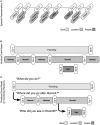Episodes, events, and models
- PMID: 26578934
- PMCID: PMC4621428
- DOI: 10.3389/fnhum.2015.00590
Episodes, events, and models
Abstract
We describe a novel computational theory of how individuals segment perceptual information into representations of events. The theory is inspired by recent findings in the cognitive science and cognitive neuroscience of event segmentation. In line with recent theories, it holds that online event segmentation is automatic, and that event segmentation yields mental simulations of events. But it posits two novel principles as well: first, discrete episodic markers track perceptual and conceptual changes, and can be retrieved to construct event models. Second, the process of retrieving and reconstructing those episodic markers is constrained and prioritized. We describe a computational implementation of the theory, as well as a robotic extension of the theory that demonstrates the processes of online event segmentation and event model construction. The theory is the first unified computational account of event segmentation and temporal inference. We conclude by demonstrating now neuroimaging data can constrain and inspire the construction of process-level theories of human reasoning.
Keywords: ACT-R/E; MDS robot; episodic memory; event segmentation; mental models; temporal reasoning.
Figures




Similar articles
-
Constructing Experience: Event Models from Perception to Action.Trends Cogn Sci. 2017 Dec;21(12):962-980. doi: 10.1016/j.tics.2017.08.005. Epub 2017 Sep 9. Trends Cogn Sci. 2017. PMID: 28899609 Free PMC article. Review.
-
Structuring Memory Through Inference-Based Event Segmentation.Top Cogn Sci. 2021 Jan;13(1):106-127. doi: 10.1111/tops.12505. Epub 2020 May 27. Top Cogn Sci. 2021. PMID: 32459391
-
Fuzzy-trace theory: dual processes in memory, reasoning, and cognitive neuroscience.Adv Child Dev Behav. 2001;28:41-100. doi: 10.1016/s0065-2407(02)80062-3. Adv Child Dev Behav. 2001. PMID: 11605365 Review.
-
Toward an integrative account of internal and external determinants of event segmentation.Psychon Bull Rev. 2024 Apr;31(2):484-506. doi: 10.3758/s13423-023-02375-2. Epub 2023 Sep 12. Psychon Bull Rev. 2024. PMID: 37698807 Review.
-
A Neurocognitive Perspective on the Forms and Functions of Autobiographical Memory Retrieval.Front Syst Neurosci. 2019 Jan 29;13:4. doi: 10.3389/fnsys.2019.00004. eCollection 2019. Front Syst Neurosci. 2019. PMID: 30760984 Free PMC article.
Cited by
-
Transcending time in the brain: How event memories are constructed from experience.Hippocampus. 2019 Mar;29(3):162-183. doi: 10.1002/hipo.23074. Epub 2019 Feb 7. Hippocampus. 2019. PMID: 30734391 Free PMC article. Review.
-
Constructing Experience: Event Models from Perception to Action.Trends Cogn Sci. 2017 Dec;21(12):962-980. doi: 10.1016/j.tics.2017.08.005. Epub 2017 Sep 9. Trends Cogn Sci. 2017. PMID: 28899609 Free PMC article. Review.
-
Episodic representation: A mental models account.Front Psychol. 2022 Jul 22;13:899371. doi: 10.3389/fpsyg.2022.899371. eCollection 2022. Front Psychol. 2022. PMID: 35936308 Free PMC article.
-
Event Boundaries in Memory and Cognition.Curr Opin Behav Sci. 2017 Oct;17:133-140. doi: 10.1016/j.cobeha.2017.08.006. Epub 2017 Sep 21. Curr Opin Behav Sci. 2017. PMID: 29270446 Free PMC article.
-
An invariant schema emerges within a neural network during hierarchical learning of visual boundaries.bioRxiv [Preprint]. 2025 Feb 4:2025.01.30.635821. doi: 10.1101/2025.01.30.635821. bioRxiv. 2025. PMID: 39975149 Free PMC article. Preprint.
References
-
- Altmann E., Trafton J. G. (2002). Memory for goals: an activation-based model. Cogn. Sci. 26, 39–83. 10.1207/s15516709cog2601_2 - DOI
-
- Anderson J. R. (2007). How Can the Human Mind Occur in the Physical Universe? New York, NY: Oxford University Press.
-
- Anderson S. J., Conway M. A. (1993). Investigating the structure of autobiographical memories. J. Exp. Psychol. Learn. Mem. Cogn. 19, 1178–1196. 10.1037/0278-7393.19.5.1178 - DOI
LinkOut - more resources
Full Text Sources
Other Literature Sources
Research Materials
Miscellaneous

